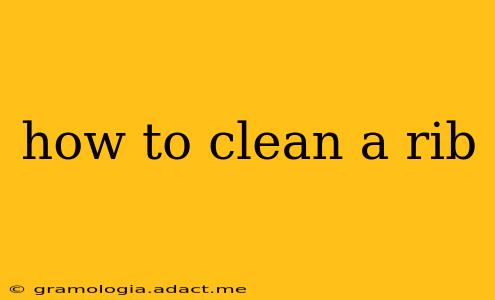Cleaning a rack of ribs properly is crucial for achieving tender, flavorful results. Whether you're working with spare ribs, baby back ribs, or St. Louis-style ribs, the process involves several key steps to ensure a delicious final product. This guide will walk you through each stage, answering common questions along the way.
What Tools Do I Need to Clean Ribs?
Before you begin, gather the following tools:
- Sharp knife: A boning knife or a sharp paring knife is ideal for trimming excess fat and membrane.
- Paper towels: For cleaning and patting the ribs dry.
- Running water: For rinsing away debris.
- Optional: Meat thermometer: To ensure the ribs are cooked to a safe internal temperature.
How Do I Remove the Rib Membrane?
The membrane, a thin, silvery skin on the bone side of the ribs, is tough and prevents the ribs from tenderizing properly. Removing it is essential for flavorful, fall-off-the-bone ribs.
- Locate the membrane: It's the thin, whitish layer on the underside of the rack of ribs.
- Loosen an edge: Use the tip of your knife to gently loosen a corner of the membrane.
- Grip and peel: Grab the loosened edge with a paper towel or your fingers and carefully peel the membrane away from the ribs. It may tear in places; that's okay. Just keep working your way across the rack.
What Should I Trim From the Ribs?
Trimming excess fat is important for preventing a greasy final product and allowing for better browning. However, some fat is desirable for flavor and moisture.
- Assess the fat: Look at the ribs and determine how much fat needs trimming. You want to remove the thick layers, but leave a thin layer of fat for flavor and moisture.
- Trim carefully: Use your sharp knife to carefully trim away excess fat. Don't trim too aggressively, or you'll risk removing too much meat.
How Do I Clean the Ribs After Trimming?
After trimming, rinse the ribs under cold running water to remove any loose debris or lingering fat particles. Then, pat the ribs dry with paper towels. This ensures even cooking and browning.
How Do I Know If My Ribs Are Clean Enough?
Your ribs are clean enough when they are free of visible debris, excess fat has been trimmed, and the membrane has been removed. They should be relatively dry to the touch after patting them with paper towels.
Should I Soak My Ribs Before Cooking?
Soaking ribs isn't necessary and can actually leach out some of their flavor. Proper trimming and cleaning are more important for achieving tender, juicy ribs.
What is the Best Way to Prepare Ribs After Cleaning?
After cleaning, your ribs are ready for seasoning and cooking. Season generously with your favorite rub and prepare them according to your chosen cooking method (smoking, grilling, baking, etc.).
How Long Should I Cook Cleaned Ribs?
The cooking time for ribs varies greatly depending on the cooking method and the desired level of doneness. Always use a meat thermometer to ensure the ribs reach a safe internal temperature of at least 145°F (63°C).
By following these steps, you can confidently clean your ribs and prepare them for a delicious meal. Remember, the key is to remove the membrane, trim excess fat, and rinse thoroughly. Happy cooking!
